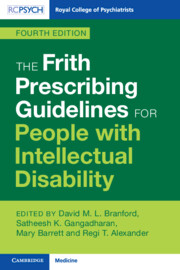Book contents
- The Frith Prescribing Guidelines for People with Intellectual Disability
- Reviews
- The Frith Prescribing Guidelines for People with Intellectual Disability
- Copyright page
- Contents
- Contributors
- Foreword
- Preface
- Acknowledgements
- Chapter 1 Intellectual Disability
- Chapter 2 Prescribing Practice
- Chapter 3 Physical Health Monitoring
- Chapter 4 Mental Health Conditions in People with Intellectual Disability
- Chapter 5 Trauma in People with Intellectual Disability
- Chapter 6 Anxiety Disorders
- Chapter 7 Depression
- Chapter 8 Bipolar Disorders
- Chapter 9 Schizophrenia
- Chapter 10 Aggression and Self-Injurious Behaviour
- Chapter 11 Personality Disorders
- Chapter 12 Sexual Offences and Paraphilias
- Chapter 13 Substance Use Disorders
- Chapter 14 Attention Deficit Hyperactivity Disorder
- Chapter 15 Autism
- Chapter 16 Sleep Disorders
- Chapter 17 Epilepsy
- Chapter 18 Dementia
- Chapter 19 Eating and Drinking Difficulties
- Chapter 20 Children and Adolescents
- Chapter 21 Prescribing for Health Issues in Women with Intellectual Disability
- Chapter 22 Older People
- Index
- References
Chapter 6 - Anxiety Disorders
Published online by Cambridge University Press: 07 November 2024
- The Frith Prescribing Guidelines for People with Intellectual Disability
- Reviews
- The Frith Prescribing Guidelines for People with Intellectual Disability
- Copyright page
- Contents
- Contributors
- Foreword
- Preface
- Acknowledgements
- Chapter 1 Intellectual Disability
- Chapter 2 Prescribing Practice
- Chapter 3 Physical Health Monitoring
- Chapter 4 Mental Health Conditions in People with Intellectual Disability
- Chapter 5 Trauma in People with Intellectual Disability
- Chapter 6 Anxiety Disorders
- Chapter 7 Depression
- Chapter 8 Bipolar Disorders
- Chapter 9 Schizophrenia
- Chapter 10 Aggression and Self-Injurious Behaviour
- Chapter 11 Personality Disorders
- Chapter 12 Sexual Offences and Paraphilias
- Chapter 13 Substance Use Disorders
- Chapter 14 Attention Deficit Hyperactivity Disorder
- Chapter 15 Autism
- Chapter 16 Sleep Disorders
- Chapter 17 Epilepsy
- Chapter 18 Dementia
- Chapter 19 Eating and Drinking Difficulties
- Chapter 20 Children and Adolescents
- Chapter 21 Prescribing for Health Issues in Women with Intellectual Disability
- Chapter 22 Older People
- Index
- References
Summary
Anxiety disorders are common mental health problems and include panic disorder, generalised anxiety disorder, post-traumatic stress disorder, and obsessive compulsive disorder. The chapter presents an overview of the condition, the treatments and medication available, and their relevance to people with intellectual disability.
Keywords
- Type
- Chapter
- Information
- Publisher: Cambridge University PressPrint publication year: 2024

